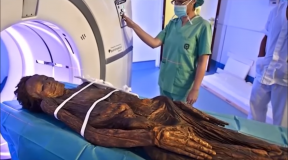The Hyksos or Hycsos ( or ;[3] Egyptian heqa khaseshet, “ruler(s) of the foreign countries”; Greek Ὑκσώς, Ὑξώς) were a multiracial people from the Middle East who took over the eastern Nile Delta, ending the Thirteenth Dynasty of Egypt and initiating the Second Intermediate Period.[4]
Important Canaanite populations first appeared in Egypt towards the end of the 12th Dynasty c. 1800 BC, and either around that time or c. 1720 BC, formed an independent realm in the eastern Nile Delta.[5] The Canaanite rulers of the Delta, regrouped in the 14th Dynasty, coexisted with the Egyptian 13th Dynasty, based in Itjtawy. The power of the 13th and 14th Dynasties progressively waned, perhaps due to famine and plague,[5][6] and c. 1650 BC both were invaded by the Hyksos, who formed their own dynasty, the 15th Dynasty. The collapse of the 13th Dynasty created a power vacuum in the south, which may have led to the rise of the 16th Dynasty, based in Thebes, and possibly of a local dynasty in Abydos.[5] Both were eventually conquered by the Hyksos, albeit for a short time in the case of Thebes. From then on, the 17th Dynasty took control of Thebes and reigned for some time in peaceful coexistence with the Hyksos kings, perhaps as their vassals. Eventually, Seqenenre Tao, Kamose and Ahmose waged war against the Hyksos and expelled Khamudi, their last king, from Egypt c. 1550 BC.[5]
The Hyksos practiced horse burials, and their chief deity, their native storm god, became associated with the Egyptian storm and desert god, Seth.[7] Although most Hyksos names seem Semitic, the Hyksos also included Hurrians, who, while speaking an isolated language, were under the rule and influence of Indo-Europeans.[8]
The Hyksos brought several technical improvements to Egypt, as well as cultural infusions such as new musical instruments and foreign loan words.[9] The changes introduced include new techniques of bronze working and pottery, new breeds of animals, and new crops.[9] In warfare, they introduced the horse and chariot,[10] the composite bow, improved battle axes, and advanced fortification techniques.[9] Because of these cultural advances, Hyksos rule was decisive for Egypt’s later empire in the Middle East.[9]
ORIGINS OF THE HYKSOS
There are various hypotheses as to the Hyksos’ ethnic identity. Most archaeologists describe the Hyksos as multi-ethnic, to include all of the peoples who occupied the Nile Delta.
The origin of the term “Hyksos” derives from the Egyptian expression hekau khaswet [HkAw xAswt] (“rulers [of] foreign lands”), used in Egyptian texts such as the Turin King List to describe the rulers of neighbouring lands. This expression begins to appear as early as the late Old Kingdom in Egypt, referring to various Nubian chieftains, and in the Middle Kingdom, referring to the Semitic chieftains of Syria and Canaan.
The German Egyptologist Wolfgang Helck once argued that the Hyksos were part of massive and widespread Hurrian and Indo-Aryan migrations into the Near East. According to Helck, the Hyksos were Hurrians and part of a Hurrian empire that, he claimed, extended over much of Western Asia during this period. Most scholars have rejected this theory, and Helck himself has now abandoned this hypothesis in a 1993 article.[11]
Modern scholarship usually assumes that the Hyksos were likely Semites who came from the Levant. Kamose, the last king of the Theban 17th Dynasty, refers to Apophis as a “Chieftain of Retjenu (i.e., Canaan)” in a stela that implies a Semitic Canaanite background for this Hyksos king: this is the strongest evidence for a Canaanite background for the Hyksos. Khyan’s name has generally been interpreted as Amorite “Hayanu” (reading h-ya-a-n) which the Egyptian form represents perfectly, and this is in all likelihood the correct interpretation.”[12] Kim Ryholt furthermore observes the name Hayanu is recorded in the Assyrian king-lists for a “remote ancestor” of Shamshi-Adad I (c. 1813 BC) of Assyria, which suggests that it had been used for centuries prior to Khyan’s own reign.[13]
The issue of Sakir-Har‘s name, one of the three earliest 15th Dynasty kings, also leans towards a West Semitic or Canaanite origin for the Hyksos rulers—if not the Hyksos peoples themselves. As Ryholt notes, the name Sakir-Har:
is evidently a theophorous name compounded with hr, Canaanite harru, [or] ‘mountain.’ This sacred or deified mountain is attested in at least two other names, both West Semitic (Yaqub-Har and Anat-Har), and so there is reason to suspect that the present name also may be West Semitic. The element skr seems identical to śkr, ‘to hire, to reward,’ which occurs in several Amorite names. Assuming that śkr takes a nominal form as in the names sa-ki-ru-um and sa-ka-ŕu-um, the name should be transliterated as either Sakir-Har or Sakar-Har. The former two names presumably mean ‘the Reward.’ Accordingly, the name here under consideration would mean ‘Reward of Har.’[14]
As to a Hyksos “conquest”, some archaeologists depict the Hyksos as “northern hordes . . . sweeping through Canaan and Egypt in swift chariots”. Yet, others refer to a ‘creeping conquest’, that is, a gradual infiltration of migrating nomads or seminomads who either slowly took over control of the country piecemeal or by a swift coup d’etat put themselves at the head of the existing government. In The World of the Past (1963, p. 444), archeologist Jacquetta Hawkes stated: “It is no longer thought that the Hyksos rulers… represent the invasion of a conquering horde of Asiatics… they were wandering groups of Semites who had long come to Egypt for trade and other peaceful purposes.” However, since then, it has been acknowledged by Egyptologists that the 14th Dynasty came for trade purposes while the 15th (the Hyksos) came in war.
JOSEPHUS
In his Against Apion, the 1st-century AD historian Josephus Flavius debates the synchronism between the Biblical account of the Exodus of the Israelites from Egypt, and two Exodus-like events that the Egyptian historian Manetho apparently mentions. It is difficult to distinguish between what Manetho himself recounted, and how Josephus or Apion interpret him. Josephus identifies the Israelite Exodus with the first exodus mentioned by Manetho, when some 480,000 Hyksos “shepherd kings” (also referred to as just ‘shepherds’, as ‘kings’ and as ‘captive shepherds’ in his discussion of Manetho) left Egypt for Jerusalem.[15] The mention of “Hyksos” identifies this first exodus with the Hyksos period (16th century BC).
Josephus provides the earliest recroded instance of the much-repeated false etymology of the term Hyksos, as a Hellenised form of the Egyptian phrase Hekw Shasu meaning Shepherd Kings. Scholars have only recently shown that the term derives from heqa-khase, a phrase meaning “rulers of foreign lands”.[16]
HYKSOS 15TH DYNASTY
Traditionally, only the Fifteenth Dynasty rulers are called Hyksos. The Greek name “Hyksos” was coined by Manetho to identify the Fifteenth Dynasty of Asiatic rulers of northern Egypt. In Egyptian Hyksos means “ruler(s) of foreign countries”, however, Josephus mistranslated Hyksos as “Shepherd Kings”.[17]
The earlier Fourteenth Dynasty had also been Semitic and/or Canaanite, however its pharaohs did not style themselves “Hyksos”, and they seem to have been vassals of the 13th Dynasty who oversaw a community of Asiatic merchants and shepherds who had been granted land in the Nile Delta. The Hyksos, by contrast, were largely Amoritic invaders who, capitalizing on a weak moment in Egypt’s history, managed to conquer the entire country briefly as far south as Thebes (under Khyan, ca. 1582 BC).
The Hyksos had Canaanite names, as seen in those with names of Semitic deities such as Anath or Ba’al. Several of their pharaohs did in fact adopt the Egyptian title hekw chasut (foreign overlords) for themselves, along with Egyptian throne names. They introduced new tools of warfare into Egypt, most notably the composite bow and the horse-drawn chariot.
The known rulers for the Hyksos 15th Dynasty are:
| Name | Dates |
|---|---|
| Sakir-Har | Named as an early Hyksos king on a doorjamb found at Avaris. Regnal order uncertain. |
| Khyan | c. 1620 BC |
| Apophis | c. 1595 BC to 1555 BC? |
| Khamudi | c. 1555 BC to 1545 BC? |
The Hyksos kingdom was centered in the eastern Nile Delta and Middle Egypt and was limited in size, never extending south into Upper Egypt, which was under the control of Theban-based rulers, except briefly, for about three years, at the end of Khyan’s reign and the beginning of Aphophis’. The Hyksos Fifteenth Dynasty rulers established their capital and seat of government at Avaris.
The rule of these kings overlaps with that of the native Egyptian pharaohs of the 16th and 17th Dynasties of Egypt, better known as the Second Intermediate Period. The first pharaoh of the 18th Dynasty, Ahmose I, finally expelled the Hyksos from their last holdout at Sharuhen in Gaza by the 16th year of his reign.[18][19] Scholars have taken the increasing use of scarabs and the adoption of some Egyptian forms of art by the Fifteenth Dynasty Hyksos kings and their wide distribution as an indication of their becoming progressively Egyptianized.[20] The Hyksos used Egyptian titles associated with traditional Egyptian kingship, and took the Egyptian god Seth to represent their own titulary deity.[21] The native Egyptians viewed the Hyksos as non-Egyptian “invaders.” When they were eventually driven out of Egypt, all traces of their occupation were erased. No accounts survive recording the history of the period from the Hyksos perspective, only that of the native Egyptians who evicted the occupiers, in this case the rulers of the Eighteenth Dynasty who were the direct successor of the Theban Seventeenth Dynasty.[22] It was the latter who started and led a sustained war against the Hyksos. Some think that the native kings from Thebes had an incentive to demonize the Asiatic rulers in the North, thus accounting for the destruction of their monuments. Scholars such as John A. Wilson found that the description of the Hyksos as overpowering, irreligious foreign rulers had support from other sources.[23]
The independent native rulers in Thebes do seem, however, to have reached a practical modus vivendi with the later Hyksos rulers. This included transit rights through Hyksos-controlled Middle and Lower Egypt and pasturage rights in the fertile Delta. One text, the Carnarvon Tablet I, relates the misgivings of the Theban ruler’s council of advisors when Kamose proposed moving against the Hyksos, whom he claimed were a humiliating stain upon the holy land of Egypt. The councilors clearly did not wish to disturb the status quo:
… we are at ease in our (part of) Egypt. Elephantine (at the First Cataract) is strong, and the middle (of the land) is with us as far as Cusae [near modern Asyut]. The sleekest of their fields are plowed for us, and our cattle are pastured in the Delta. Emmer is sent for our pigs. Our cattle have not been taken away… He holds the land of the Asiatics; we hold Egypt…
WAS THERE A HYKSOS INVASION?
Manetho‘s account, as recorded by Josephus, describes the appearance of the Hyksos in Egypt as an armed invasion by a horde of foreign barbarians who met little resistance, and who subdued the country by military force. He records that the Hyksos burnt their cities, destroyed temples, and led women and children into slavery.[25]
It has been claimed[26] that new revolutionary methods of warfare ensured the Hyksos the ascendancy in their influx into the new emporia being established in Egypt’s delta and at Thebes in support of the Red Sea trade. Herbert E. Winlock describes new military hardware, such as the composite bow, as well as the improved recurve bow, and most importantly the horse-drawn war chariot, as well as improved arrowheads, various kinds of swords and daggers, a new type of shield, mailed shirts, and the metal helmet.[26]
In recent years the idea of a simple Hyksos migration, with little or no violence, has gained support.[27] According to this theory, the Egyptian rulers of 13th Dynasty were preoccupied with domestic famine and plague, and they were too weak to stop the new migrants from entering and settling in Egypt. Even before the migration, Amenemhat III carried out extensive building works and mining, and Gae Callender notes that “the large intake of Asiatics, which seems to have occurred partly in order to subsidize the extensive building work, may have encouraged the so-called Hyksos to settle in the Delta, thus leading eventually to the collapse of native Egyptian rule.”[28]
By around 1700 BC (just over a hundred years later), Egypt was fragmenting politically, with local kingdoms springing up in the northeastern Delta area. One of these was that of King Nehesy, whose capital was at Avaris; he ruled over a population consisting largely of Syro-Canaanites who had settled in the area during the 12th Dynasty, and who were probably mainly soldiers, sailors, shipbuilders and workmen. His dynasty was probably replaced by a West-Semitic speaking Syro-Canaanite dynasty that formed the basis of the later Hyksos kingdom, able to spread southwards because of the unstable political situation while aided by “an army, ships, and foreign connections.”[29]
Josephus, quoting from the work of the historian Manetho, described more of an Egyptian assimilation to the corrupt ways of the emporia, followed by a rebellion of those who wished to perpetuate native Egyptian centered culture, rather than any kind of military struggle.
By main force they easily seized it without striking a blow; and having overpowered the rulers of the land, they then burned our cities ruthlessly, razed to the ground the temples of gods… Finally, they appointed as king one of their number whose name was Salitis. He had his seat at Memphis, levying tribute from Upper and Lower Egypt and always leaving garrisons behind in the most advantageous positions
Recent archaeological finds at Edfu could perhaps establish that the Hyksos 15th Dynasty was already in existence at least by the mid-13th Dynasty reign of king Sobekhotep IV. In a 2011 paper by Nadine Moeller, Gregory Marouard and N. Ayers,[30] these three scholars discuss the discovery of an important early-12th Dynasty (Middle Kingdom) administrative building in the eastern Tell Edfu area of Upper Egypt which was in continual use into the early Second Intermediate Period until the 17th Dynasty when its remains were sealed up by a large silo court. Fieldwork by these Egyptologists in 2010 and 2011 led to the discovery of a large adjoining hall which proved to contain 41 sealings showing the cartouche of the Hyksos ruler Khyan together with 9 sealings naming the 13th Dynasty king Sobekhotep IV.[31] The secure and sealed contexts of these seals likely demonstrate that Sobekhotep IV and Khyan were contemporaries. This would mean that the 13th Dynasty did not control all of Egypt when Sobekhotep IV acceded to power and that there was a significant overlap between the 13th and 15th Dynasties since Sobekhotep IV was only a mid-13th Dynasty ruler -— although one of its most powerful kings. Therefore, Manetho’s statement that the Hyksos 15th Dynasty violently replaced the 13th Dynasty would appear as a piece of later Egyptian propaganda. This analysis of the discoveries in Edfu as well as the conclusions drawn from it are rejected by Robert Porter however, who argues that Khyan ruled much later than Sobekhotep IV and that the seals of a pharaoh were used even long after his death.[32]
The ceramic evidence in the Memphis-Fayum region of Lower Egypt also argues against the presence of new invading foreigners. Janine Bourriau’s excavation in Memphis of ceramic material retrieved from Lisht and Dahshur during the Second Intermediate Period shows a continuity of Middle Kingdom ceramic type wares throughout this era. She finds in them no evidence of intrusion of Hyksos-style wares.[33] Bourriau’s evidence strongly suggests that the traditional Egyptian view, long espoused by Manetho, that the Hyksos invaded and sacked the Memphite region and imposed their authority there, is fictitious.
Not until the beginning of the Theban wars of liberation during the 17th Dynasty are Theban wares again found in the Fayum-Memphis region. Some texts indicate that while the Hyksos controlled the Delta region administratively, the Thebans were too busy mining gold and making money off the Red Sea trade to care. Lower Egypt and Thebes functioned autonomously, and shared limited contact with each other.[34]
Bourriau argues that Manetho’s description of Hyksos rule is confirmed by the evidence in the Kamose texts: Kamose’s rejection of vassal status, the strict control of the border at Cusae, the imposition of taxes on all Nile traffic, and the existence of garrisons of Asiatics led by Egyptian commanders.[35]
By the Thirteenth Dynasty of Egypt, the “foreign warlords” had taken the name of Pharaoh for themselves, and had begun to fight over it. Some argued there was no need to pay tribute, homage or obedience to a weak king, and that began to cause problems.
Supporters of the peaceful takeover of Egypt claim there is little evidence of battles or wars in general in this period.[36] They also maintain that the chariot didn’t play any relevant role, e.g. no traces of chariots have been found at the Hyksos capital of Avaris, despite extensive excavation.[37]
As the chariot became an important weapon of the nobles and kings of that period, it became a symbol of power throughout Eurasia, Mycenaean Greece, India, Mesopotamia, Eastern Europe and China. Kings were portrayed on chariots, went to war in chariots, and were buried in chariots.
THEBAN OFFENSIVE
UNDER SEQENENRE TAO
The revolt which drove the Hyksos from Upper Egypt began in the closing years of the Seventeenth Dynasty at Thebes. Later New Kingdom literary tradition has brought one of these Theban kings, Seqenenre Tao, into contact with his Hyksos contemporary in the north, Auserra Apophis (also known as Apepi or Apophis). The tradition took the form of a tale in which the Hyksos king Apophis sent a messenger to Seqenenre in Thebes to demand that the Theban sport of harpooning hippopotami be done away with; his excuse was that the noise of these beasts was such that he was unable to sleep in far-away Avaris. The real reason was probably that their main god was Seth, who was represented as part man, part hippopotamus. Jan Assmann argues that because the Ancient Egyptians could never conceive of a “lonely” god lacking personality, Seth the desert god, who was worshipped exclusively according to the tale, represented a manifestation of evil.[38] Perhaps the only historical information that can be gleaned from the tale is that Egypt was a divided land, the area of direct Hyksos control being in the north, but the whole of Egypt possibly paying tribute to the Hyksos kings.
Seqenenre participated in active diplomatic posturing, which probably consisted of more than simply exchanging insults with the Asiatic ruler in the North. He seems to have led military skirmishes against the Hyksos, and judging by the vicious head wounds on his mummy in the Cairo Museum, he may have died during one of them. His son and successor, Wadjkheperre Kamose, the last ruler of the Seventeenth Dynasty at Thebes, is credited with the first significant victories in the Theban-led war against the Hyksos.
UNDER KAMOSE
Kamose sailed north from Thebes at the head of his army in his third regnal year. He surprised and overran the southernmost garrison of the Hyksos at Nefrusy, just north of Cusae [near modern Asyut], and Kamose then led his army as far north as the neighborhood of Avaris itself. Though the city was not taken, the fields around it were devastated by the Thebans. A second stele discovered at Thebes continues the account of the war broken off on the Carnarvon Tablet I, and mentions the interception and capture of a courier bearing a message from the Hyksos king Aawoserra Apophis at Avaris to his ally the ruler of Kush (modern Sudan), requesting the latter’s urgent support against the threat posed by Kamose’s activities against both their kingdoms. Kamose promptly ordered a detachment of his troops to occupy the Bahriya Oasis in the Western Desert to control and block the desert route to the south. Kamose, called “the Strong,” then sailed back up the Nile to Thebes for a joyous victory celebration, after what was probably not much more than a surprise spoiling raid in force that caught the Hyksos off guard. His Year 3 is the only date attested for Kamose and he may have died shortly after the battle from wounds.[29]
By the end of the reign of Apophis, perhaps the second last Hyksos kings of the Fifteenth Dynasty, the Hyksos had been routed from Middle Egypt and had retreated northward and regrouped in the vicinity of the entrance of the Fayyum at Atfih. This Greater Hyksos king had outlived his first Egyptian contemporary, Seqenenra Tao II, and was still on the throne (albeit of a much reduced kingdom) at the end of Kamose’s reign. The last Hyksos ruler of the Fifteenth Dynasty, Khamudi, undoubtedly had a relatively short reign that fell within the first half of the reign of Ahmose, Kamose’s successor and the founder of the Eighteenth Dynasty.
UNDER AHMOSE
Ahmose I, who is regarded as the first king of the Eighteenth Dynasty may have been on the Theban throne for some time before he resumed the war against the Hyksos.
The details of his military campaigns are taken from the account on the walls of the tomb of another Ahmose, a soldier from El-Kab, a town in southern Upper Egypt, whose father had served under Seqenenra Tao II, and whose family had long been nomarchs of the districts. It seems that several campaigns against the stronghold at Avaris were needed before the Hyksos were finally dislodged and driven from Lower Egypt. When this occurred is not known with certainty. Some authorities place the expulsion as early as Ahmose’s fourth year, while Donald Redford, whose chronological structure has been adopted here, places it as late as the king’s fifteenth year. The Ahmose who left the inscription states that he followed on foot as his King Ahmose rode to war in his chariot (the first mention of the use of the horse and chariot by the Egyptians); in the fighting around Avaris he captured prisoners and carried off several hands (as proof of slain enemies), which when reported to the royal herald resulted in his being awarded the “Gold of Valor” on three separate occasions. The actual fall of Avaris is only briefly mentioned:
Then Avaris was despoiled. Then I carried off spoil from there: one man, three women, a total of four persons. Then his majesty gave them to me to be slaves.[39]
After the fall of Avaris, the fleeing Hyksos were pursued by the Egyptian army across northern Sinai and into southern Canaan. Here, in the Negev desert between Rafah and Gaza, the fortified town of Sharuhen was reduced after, according to the soldier from El-Kab, a long three-year siege operation. How soon after the sack of Avaris this Asiatic campaign took place is uncertain. One can reasonably conclude that the thrust into southern Canaan probably followed the Hyksos’ eviction from Avaris fairly closely, but, given a period of protracted struggle before Avaris fell and possibly more than one season of campaigning before the Hyksos were shut up in Sharuhen, the chronological sequence must remain uncertain.
LATER TIMES
The Hyksos continued to play a role in Egyptian literature as a synonym for “Asiatic” down to Hellenistic times. The term was frequently evoked against such groups as the Semites settled in Aswan or the Delta, and this may have led the Egyptian priest and historian Manetho to identify the coming of the Hyksos with the sojourn in Egypt of Joseph and his brothers, and led to some authors identifying the expulsion of the Hyksos with the Exodus. With the chaos at the end of the 19th Dynasty, the first pharaohs of the 20th Dynasty in the Elephantine Stele and the Harris Papyrus re-invigorated an anti-Hyksos stance to strengthen their nativist reaction towards the Asiatic settlers of the north, who may again have been expelled from the country. Setnakht, the founder of the 20th Dynasty, records in a Year 2 stela from Elephantine that he defeated and expelled a large force of Asiatics who had invaded Egypt during the chaos between the end of Twosret‘s reign and the beginning of the 20th Dynasty and captured much of their stolen gold and silver booty.
The story of the Hyksos was known to the Greeks,[40] who attempted to identify it within their own mythology with the expulsion from Egypt of Belos (Baal?[41] and the daughters of Danaos, associated with the origin of the Argive Dynasty.
SEE ALSO
NOTES
- Aharoni, Yohanan and Michael Avi-Yonah, The MacMillan Bible Atlas, Revised Edition, pp. 30–31 (1968 & 1977 by Carta Ltd.).
- von Beckerath, Jürgen. Untersuchungen zur politischen Geschichte der zweiten Zwischenzeit in Ägypten (1965) [Ägyptologische Forschungen, Heft 23]. Basic to any study of this period.
- Bietak M., Avaris, the Capital of the Hyksos. Recent Excavations at Tell el-Dab’a, 1996
- Bimson, John J. Redating the Exodus. Sheffield, England: Sheffield Academic Press, 1981. ISBN 0-907459-04-8
- Charlotte Booth: The Hyksos period in Egypt. Princes Risborough, Shire 2005. ISBN 0-7478-0638-1
- Gardiner, Sir Alan. Egypt of the Pharaohs (1964, 1961). Still the classic work in English. See pp. 61–71 for his examination of chronology.
- Gibson, David J., Whence Came the Hyksos, Kings of Egypt?, 1962
- Hayes, William C. “Chronology: Egypt—To End of Twentieth Dynasty,” in Chapter 6, Volume 1 of The Cambridge Ancient History, Revised Edition. Cambridge, 1964. With excellent bibliography up to 1964. This is CAH’s chronology volume: A basic work.
- Hayes, William C. “Egypt: From the Death of Ammenemes III to Seqenenre II,” in Chapter 2, Volume 2 of The Cambridge Ancient History, Revised Edition (1965) (Fascicle 6).
- Helck, Wolfgang. Die Beziehungen Ägyptens zu Vorderasien im 3. und 2. Jahrtausend v. Chr. (1962) [Ägyptologische Abhandlungen, Band 5]. An important review article that should be consulted is by William A. Ward, in Orientalia 33 (1964), pp. 135–140.
- Hornung, Erik. Untersuchungen zur Chronologie und Geschichte des Neuen Reiches (1964) [Ägyptologische Abhandlungen, Band 11]. With an excellent fold-out comparative chronological table at the back with 18th, 19th, and 20th Dynasty dates.
- James, T.G.H. “Egypt: From the Expulsion of the Hyksos to Amenophis I,” in Chapter 2, Volume 2 of The Cambridge Ancient History, Revised Edition (1965) (Fascicle 34).
- Montet, Pierre. Eternal Egypt (1964). Translated by Doreen Weightman.
- Eliezer D. Oren (Hrsg.): The Hyksos, new historical and archaeological perspectives. Kongressbericht. University Museum Philadelphia. University of Pennsylvania, Philadelphia 1997. ISBN 0-924171-46-4
- Pritchard, James B. (Editor). Ancient Near Eastern Texts Relating to the Old Testament(ANET), 3rd edition. (1969). This edition has an extensive supplement at the back containing additional translations. The standard collection of excellent English translations of ancient Near Eastern texts.
- Redford, Donald B. History and Chronology of the Eighteenth Dynasty of Egypt: Seven Studies. (1967).
- Redford, Donald B. “The Hyksos Invasion in History and Tradition,” Orientalia 39 (1970).
- Redford Donald B. Egypt, Canaan and Israel in ancient times, 1992
- Redford Donald B. “The Hyksos in history and tradition,” Orientalia, 39, 1997, 1-52
- K. Ryholt. The Political Situation in Egypt during the Second Intermediate Period c.1800-1550 B.C. (1997) by Museum Tuscalanum Press.
- Säve-Söderbergh, T. “The Hyksos Rule in Egypt,” Journal of Egyptian Archaeology 37 (1951), pp. 53–71.
- Van Seters, John. The Hyksos: A New Investigation (1967). Two reviews of this volume should be consulted: Kitchen, Kenneth A. “Further Notes on New Kingdom Chronology and History,” in Chronique d’Égypte XLIII, No. 86, 1968, pp. 313–324; and Simpson, William J. Review, in Journal of the American Oriental Society 90 (1970), pp. 314–315.
- Winlock, H. E. The Rise and Fall of the Middle Kingdom in Thebes (1947). Still a classic with much important information.
This article was republished from gutenberg.org







